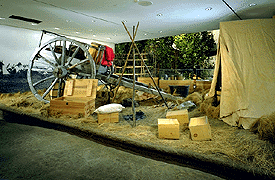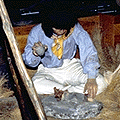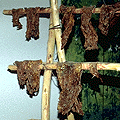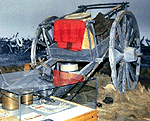Canada Hall
 Metis Bison Hunters
Metis Bison Hunters
As beaver pelts became difficult to find in eastern regions, traders were forced to go farther north and west. Contact between cultures, and the intermarriage of Native people and traders, brought significant changes to the economic and social fabric of the land, including the birth of a unique Metis culture on the plains of southern Manitoba.
As French coureurs des bois were integrated into Cree and Ojibwa communities in the Upper Great Lakes region, the population became increasingly racially mixed. A similar situation developed to the north, around Hudson Bay, as children were born from relationships between Irish or Scottish traders and Cree women. In the late eighteenth century, these people moved into the western and northern interior of the country, giving rise to the Metis nation. They adopted elements from both sides of their heritage to become a distinct culture that began to crystallize in the early nineteenth century.

By that time, some Metis were gravitating to permanent settlements at the junction of the Red and Assiniboine rivers. In the fall of 1801, a group of Metis settled on the banks of the Red River where Winnipeg now stands. They were called "freemen" because they were bound neither by Inidan custom nor fur trade company law. Their long, narrow river lots were reminiscent of farms along the St. Lawrence Valley. Three main groups emerged -- buffalo hunters, traders, and voyageurs -- and their cultural characteristics varied greatly depending on how much they had retained of the original Native and European cultures.
One sector of the Metis population depended primarily on the bison hunt for its livelihood. These Metis left their settlements every June to hunt bison. The Metis fiercely guarded their customary rights to hunt and trade freely throughout the prairies. Rallying together under the cry le commerce est libre! (freedom of trade!), the Metis effectively ended the Hudson's Bay Company's trade monopoly.
Besides being an important food-gathering activity and a commercial endeavour, the hunt was a social occasion that brought together families who saw each other only a few times a year. Every spring and fall, as many as 1,600 people would gather at Pembina, on the Red River, to elect a provisional government. Mounted scouting parties maintained order within the temporary community, enforcing compliance with the strict rules of the hunt and providing protection from attacks by rival groups such as the Dakotas.
The hunting technique used by the Metis differed considerably from that of their Cree ancestors. Instead of driving bison off cliffs or into enclosures, they used horses and firearms. Creating a stampede, the hunters ran their horses into the herd and selected the animals they wanted to kill, firing point-blank at full gallop. An experienced hunter on a well-trained horse could down ten to twelve bisons in a two-hour run.



Back at the encampment, women and children spent several days processing the meat of the slaughtered bison into pemmican. While the meat was dried in the summer sun and bison fat (added to preserve the mixture) was being melted, children pounded saskatoon berries and chokecherries as flavourings. After pulverizing the brittle dried meat with flails, women then mixed all the ingredients together with a shovel and left this mixture to congeal into pemmican in large rawhide sacks like those seen in the Red River cart on display. This lightweight, highly nutritious food would last almost indefinitely, making it ideal for nomadic people. The Metis kept some pemmican for themselves, but the bulk of it was sold to fur trade companies, who used it as a staple food for their traders and voyageurs.
The bison was a virtual supermarket, providing all the necessities of life. No part of the animal was wasted. The meat, fat, organs, and bone marrow provided food, while the skins were converted into tent covers, sleeping robes, clothing, and moccasins. Bones were fashioned into tools and ribs into sled runners. Hollowed-out horns became drinking goblets and containers for gun powder. Perforated incisor teeth were strung into necklaces, and vertebrae were fashioned into game pieces used for gambling. The bladder made an ideal water bag, and the tail was an excellent fly swatter. Finally, dried dung, known as buffalo chips, provided an abundance of fuel on the treeless prairies.
The bonding of women and children during the long, hard days of pemmican-making gave an enduring matriarchal focus to Metis family relations. Metis women made clothing and riding gear as trade goods, decorating them with a distinctive floral style. They employed patterns that were distinctive to their own communities, evolving new styles over time according to changing tastes and availability of materials.
 Built from oak, the Red River cart hauled buffalo meat and hides during
the annual hunts. Pulled by an ox, it could carry a half-ton for twenty
miles (32 km.) a day. In the 1840 hunt, more than 1,000 carts travelled
for two months over the Canadian prairies. Driven by women, with their
children on board, the carts also transported the hunt's supplies. Trails
were cut by great convoys of carts, moving sixteen abreast.
Built from oak, the Red River cart hauled buffalo meat and hides during
the annual hunts. Pulled by an ox, it could carry a half-ton for twenty
miles (32 km.) a day. In the 1840 hunt, more than 1,000 carts travelled
for two months over the Canadian prairies. Driven by women, with their
children on board, the carts also transported the hunt's supplies. Trails
were cut by great convoys of carts, moving sixteen abreast.

